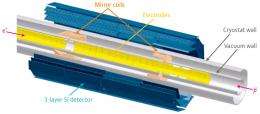Antimatter sticks around

By successfully confining atoms of antihydrogen for an unprecedented 1,000 seconds, an international team of researchers called the ALPHA Collaboration has taken a step towards resolving one of the grand challenges of modern physics: explaining why the Universe is made almost entirely of matter, when matter and antimatter are symmetric, with identical mass, spin and other properties. The achievement is remarkable because antimatter instantly disappears on contact with regular matter such that confining antimatter requires the use of exotic technology.
The collaboration of 39 researchers, including Daniel Miranda Silveira and Yasunori Yamazaki from the RIKEN Advanced Science Institute, Wako, trapped antihydrogen inside a ‘bottle’ defined by a set of magnetic fields created by an octupole magnetic coil and a pair of mirror coils (Fig. 1). The bottle could not confine antihydrogen atoms unless they had extremely low energy, which represents a particular problem because antimatter is made through an extremely energetic process; and any cooling procedures must prevent antimatter and matter from meeting. In a previous ALPHA Collaboration experiment, the researchers succeeded in confining 38 antihydrogen atoms for at least one-fifth of a second.
Buoyed by their success, the collaboration focused on further cooling the antihydrogen atoms. Advances they made to two techniques proved especially fruitful. The first, evaporative cooling, relies on the fact that any collection of antiparticles will include some that are more energetic than others. By confining this collection inside an energy potential that lets only the most energetic particles escape, or evaporate, the entire collection can be effectively cooled, and can reach hundreds of degrees Celsius below freezing, Yamazaki explains. The second technique, autoresonant mixing, uses a technique called phase locking to mix the two constituents of antihydrogen—antiprotons and positrons—without warming the antiprotons.
Once cooled in this way, the ALPHA Collaboration was able to trap more antimatter atoms, some for times exceeding 1,000 seconds. Critically, this is much longer than the time it takes for antimatter to relax to its lowest-energy, or ground, quantum mechanical state, which is a prerequisite for studying its properties with laser and microwave spectroscopic techniques.
Trapping antimatter atoms in this way will allow physicists to address questions regarding the symmetry between matter and antimatter, which is currently understood to be a foundational property of physics, says Yamazaki. “If we see even a slight difference between hydrogen and antihydrogen properties, then the standard model of physics will need to be rewritten, and our understanding of the Universe will change.”
More information: Andresen, G.B., et al. Confinement of antihydrogen for 1,000 seconds. Nature Physics 7, 558–564 (2011).
Provided by RIKEN





















